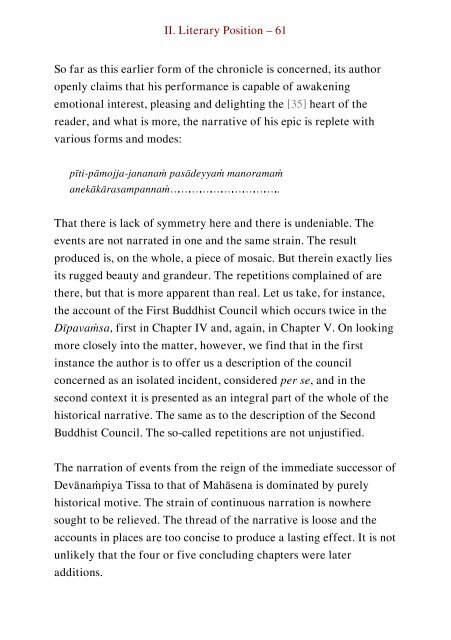On the Chronicles of Ceylon
A judicious appraisal of the various Chronicles that were written in Sri Lanka, assessing their chronology, literary and historical character.
A judicious appraisal of the various Chronicles that were written in Sri Lanka, assessing their chronology, literary and historical character.
- No tags were found...
You also want an ePaper? Increase the reach of your titles
YUMPU automatically turns print PDFs into web optimized ePapers that Google loves.
II. Literary Position – 61<br />
So far as this earlier form <strong>of</strong> <strong>the</strong> chronicle is concerned, its author<br />
openly claims that his performance is capable <strong>of</strong> awakening<br />
emotional interest, pleasing and delighting <strong>the</strong> [35] heart <strong>of</strong> <strong>the</strong><br />
reader, and what is more, <strong>the</strong> narrative <strong>of</strong> his epic is replete with<br />
various forms and modes:<br />
pīti-pāmojja-jananaṁ pasādeyyaṁ manoramaṁ<br />
anekākārasampannaṁ………………………….<br />
That <strong>the</strong>re is lack <strong>of</strong> symmetry here and <strong>the</strong>re is undeniable. The<br />
events are not narrated in one and <strong>the</strong> same strain. The result<br />
produced is, on <strong>the</strong> whole, a piece <strong>of</strong> mosaic. But <strong>the</strong>rein exactly lies<br />
its rugged beauty and grandeur. The repetitions complained <strong>of</strong> are<br />
<strong>the</strong>re, but that is more apparent than real. Let us take, for instance,<br />
<strong>the</strong> account <strong>of</strong> <strong>the</strong> First Buddhist Council which occurs twice in <strong>the</strong><br />
Dīpavaṁsa, first in Chapter IV and, again, in Chapter V. <strong>On</strong> looking<br />
more closely into <strong>the</strong> matter, however, we find that in <strong>the</strong> first<br />
instance <strong>the</strong> author is to <strong>of</strong>fer us a description <strong>of</strong> <strong>the</strong> council<br />
concerned as an isolated incident, considered per se, and in <strong>the</strong><br />
second context it is presented as an integral part <strong>of</strong> <strong>the</strong> whole <strong>of</strong> <strong>the</strong><br />
historical narrative. The same as to <strong>the</strong> description <strong>of</strong> <strong>the</strong> Second<br />
Buddhist Council. The so-called repetitions are not unjustified.<br />
The narration <strong>of</strong> events from <strong>the</strong> reign <strong>of</strong> <strong>the</strong> immediate successor <strong>of</strong><br />
Devānaṁpiya Tissa to that <strong>of</strong> Mahāsena is dominated by purely<br />
historical motive. The strain <strong>of</strong> continuous narration is nowhere<br />
sought to be relieved. The thread <strong>of</strong> <strong>the</strong> narrative is loose and <strong>the</strong><br />
accounts in places are too concise to produce a lasting effect. It is not<br />
unlikely that <strong>the</strong> four or five concluding chapters were later<br />
additions.


















